Samsung Q60T
Product Name: Samsung Q60T
Product Description: 2020 4K QLED TV
-
Design - 8.5/10
8.5/10
-
Video Quality - 8.3/10
8.3/10
-
Inputs and Ports - 8.5/10
8.5/10
-
OS, Apps and Features - 9.5/10
9.5/10
-
Price / Quality - 8.8/10
8.8/10
Summary
Total Score
Pros
- Very vivid colors
- Blazing fast input lag
- Tizen has huge support
- Most affordable QLED
Cons
- HDR brightness is average
- Motion showed some ghosting
- No FreeSync this year
- Dolby Vision is not supported
Cheapest Places to Buy :
*We are a reader-supported website. When you buy through links on our site, we may earn a small affiliate commission at no extra cost to you. Home Media Entertainment does not accept money for reviews.*
In a way today’s article marks the beginning of 2020 TV reviews that most manufacturers had shown us in CES 2020 back in January. And what better way to start with by reviewing a TV from the largest TV manufacturer the last few years that is no other than Samsung. For 2020 Samsung is offering 4 different series including the 8K QLEDs, 4K QLEDs, 4K Crystal series and the Lifestyle series.
Both their QLED series are supposed to include their premium models with Samsung starting to push on the 8K front more and more while the Crystal series include a couple of more cost friendly and less capable 4K models. In our Samsung Q60T review we will be looking into the lowest QLED on offer and if it can offer the kind of image quality that QLEDs are known for.
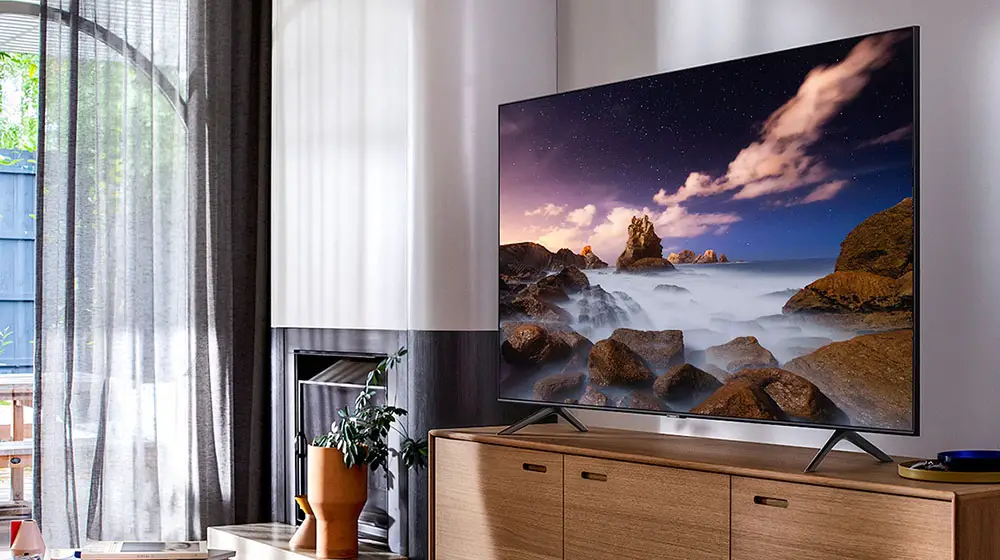
QLEDs got their name from their Quantum Dot technology being used in order to display more colors on screen and this is one single characteristic that all of them have. But with the Q60T pushing the price downwards major cuts had to be done across the board in order to be on budget.
The Q60T may be considered a QLED but comes with a less capable Quantum Processor 4K Lite, it had a less accurate Edge lit system and comes with a more simple audio system. But with such a lower price compared to the other models in the series are these cuts so significant to consider the Q60T a half baked QLED model or it can proudly stand as part of this otherwise remarkable series? Keep reading as we put it to the test.
Design
A few years back Samsung had the remarkable idea to create the One Connect Box which was a separate box with all the ports and connections and use a single cable to connect it to the TV. We thought that as the years would go by we would start to see this in more and more models. Unfortunately it seems that Samsung has decided to keep this only for their top 8K and 4K QLEDs for this year making it somewhat of an extremely premium feature.
The Q60T uses the more traditional design of keeping all ports at the back of the unit and using an edge lit system meaning that this model is in general very thin. In fact the unit is even slightly thinner that last year’s Q60R as we measured it around 2.36″ (6 cm) at it’s most thick lower part. TVs that use edge lit panels are generally very thin as they don’t use a full array of backlights that could add to it’s overall thickness. As a result the Q60T will look very nice if you plan to wall mount it.
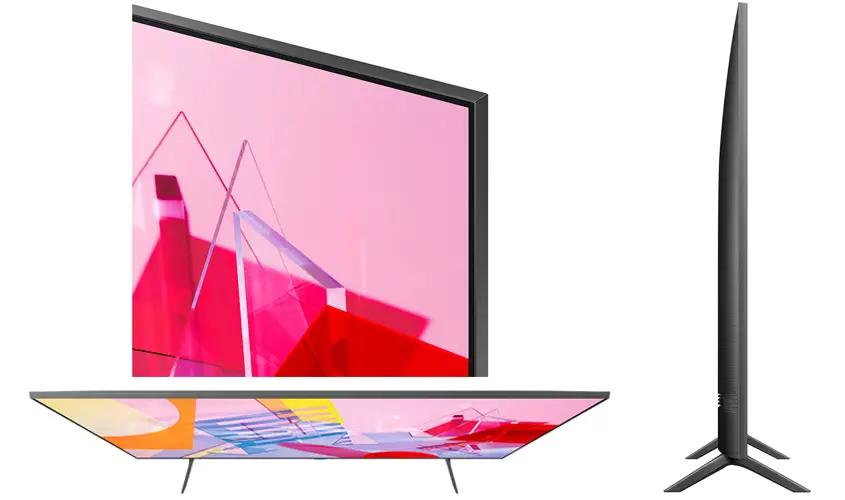
Usually the back of Samsung TVs feature an interesting plastic back face with some nice texture and the Q60T is no different. It’s not the kind of back face that screams quality but everything is well organized and nicely built without any excessive design lines. On the left side we find the two groups of ports while the power connector is kept on the right side. There is also a set of straight grooves on the bottom part where you can guide you cables while special clips can attach to the back of the stand. On the back we also find the holes for a VESA wall mount to be used.
And since we are talking about the stand the Q60T is using a bench type design with two legs that attach at both edges of the panel. This type of stand may not be the best looking one but certainly keeps the TV far more stable that the usual Y-shaped stands we get in the more premium models. This doesn’t mean the TV is completely wobble free but is far more stable than could ever be.
For one more year our familiar One Remote is the main remote being used in most middle and top tier models while changes from previous years are almost non existent. There have been a few variations of this remote, with this unit getting the more standard gun-metal black arch back design. For this year we continue to get the three dedicated buttons below the volume and channels controls with the only change being the Hulu service have been changed and now it has Samsung TV plus.

Everything else is exactly the same with the remote having a built-in microphone that you can use for the TV’s voice control features. It also continues to have the ability to act as a universal remote either if your other devices support HDMI-CEC or not. The other buttons and general layout remains the same and keeps getting high scores from us as we always adored Samsung’s approach of a low count buttons design for many years now as the main focus is on the visual UI on the TV instead of having a jam packed remote to use. The remote felt very responsive and there were no visible delays between our commands and the action on screen.
Closing the Q60T is a TV that will mostly go unnoticed. We didn’t have any major complaints but we can also say that we were not particularly excited either by the design or the quality. Being the cheapest QLED available it was bound to be like that so no surprises here.
Video Quality
Processor technology used
One of the key marketing aspects Samsung has been using for their 4K QLED series is the use of Quantum Processor 4K with it’s amazing AI upscaling engine as well as sound processing. Unfortunately the Q60T is the only QLED model that is noτ using this specific silicone and instead comes with what is called Quantum Processor 4K Lite.
Now Samsung has not provided any details on what this “Lite” version has in comparison to the standard version but from what we have seen the Q60T is not using the same AI algorithms for it’s image upscaling. This means that while this unit can upscale any lower resolution image in 4K this is not done in the same efficient way. We tried some Full HD as well as SD content and to be completely honest we didn’t see any major problems with the end result. Obviously in order to see any visible difference we would have to compare it side by side with a TV that can do AI upscaling but we didn’t have that ability at the time of writing.

As it is the Q60T processing capabilities may be lower than the other QLED models but was still very good for it’s class. Lastly we shouldn’t forget to mention that due to the lower processing abilities of this “Lite” version we also loose some of the sound features we see in the higher tier units.
Lighting technology used
While the top units in the QLED series are equipped with Full Array with Local Dimming (FALD) lighting systems the Q60T along with the next model in the series, the Q70T, come with an Edge LED system. This means that the Q60T instead of having the LEDs behind the panel there is an array of LEDs on the top and bottom of the screen. This type of backlight is cheaper to incorporate and thus is used in the lower tier models but as a result we get less light control and precision compared to a FALD system.
But while the Q60T is fundamentally using an Edge lit system for 2020 Samsung seems to have made some tweaks to it in order to improve, in theory at least, the final result. Samsung calls it a Dual LED system which uses two different LED colors and adjusts the color tone according to the image being displayed. Additionally there is no local dimming that could further help with the weaknesses such a system has.
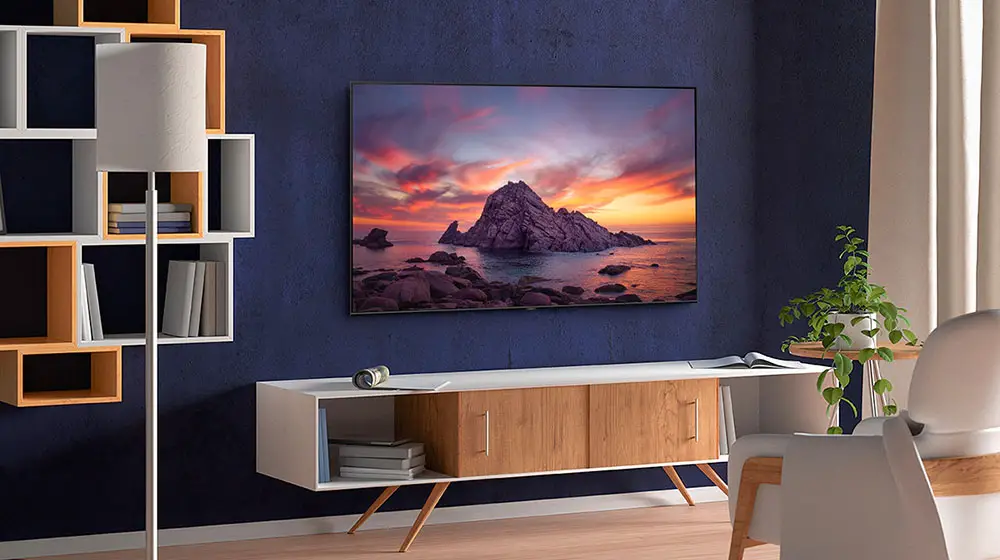
Other than that this type of system comes with the usual advantages and disadvantages. On the positive side TVs with such a system tend to be slightly thinner but on the opposite side we tend to see strips of light from top to bottom when a bright object is displayed on the dark background.
With the Q60T being at the bottom of the performance ladder as far as the QLEDs are concerned we were more or less expecting to find such a system in this one. We would definitely be surprised otherwise but as we see that the Q70T also incorporates such a system it’s normal to find it here also.
Brightness / Contrast
Let’s take a look at the unit’s brightness capabilities now. As usual we used the Movie mode when making our measurements and SDR brightness over a 10% window gave us a result of 453 nits which is very good and adequate for any kind of SDR content. If you will be watching a lot of Full HD or lower resolution content the Q60T can handle it exceptionally. Now when it comes to HDR brightness, over a 10% window we got about 461 nits which is average at best and it cannot create the dazzling effect HDR is known for. For a TV that belongs in the supposedly premium QLED series we were expecting a bit more.
As far as the contrast is concerned the TV comes with a VA panel which results in very good overall contrast with deep blacks and although local dimming could further enhance this unfortunately we don’t get that here.
In general we would say that the Q60T seems to perform slightly better than last year’s Q60R which is a good thing but the difference is very small to have any huge impact in the final picture quality.
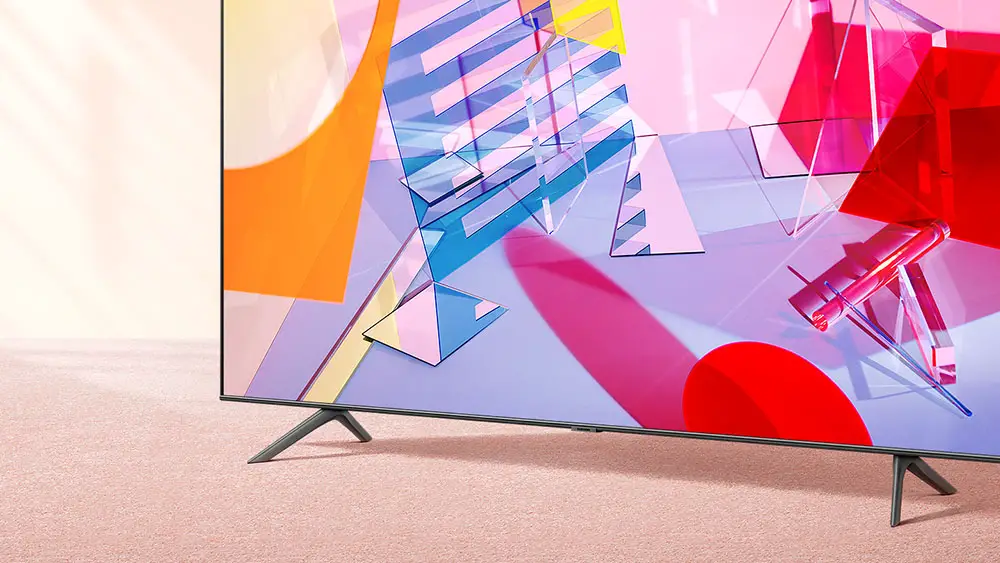
Viewing angles
As we already mentioned this model, as most TVs from Samsung, uses a VA panel and as a result the viewing angles are not that good. For this year Samsung has added in the Q60T a technology called Wide Viewing Angle which is a step down from the Ultra Viewing Angle tech being used in the top tier models.
This basically is an extra layer on the panel that is responsible of minimizing the light leakage by focusing the light on the right direction. As a result we get better viewing angles and this seems evident on this one. We could say that the maximum angle that image integrity was kept was around 25% or slightly above that. But at anything more than 30% and the image would start to degrade very much to consider satisfactory.
HDR support
When it comes to HDR support things haven’t changed at all lately but definitely got interesting. Samsung is a founding member of the HDR10+ Alliance together with Panasonic and 20th Century Fox. But now that the renamed 20th Century Studios belong to Disney they seem to have abandoned the format in favor of the rival Dolby Vision. The complications of this move are not yet known but Samsung is no small player. Don’t forget that we are talking about the number one TV manufacturer in the world that still backs up their own HDR10+ so everything is still up in the air as far as the result of this HDR war.
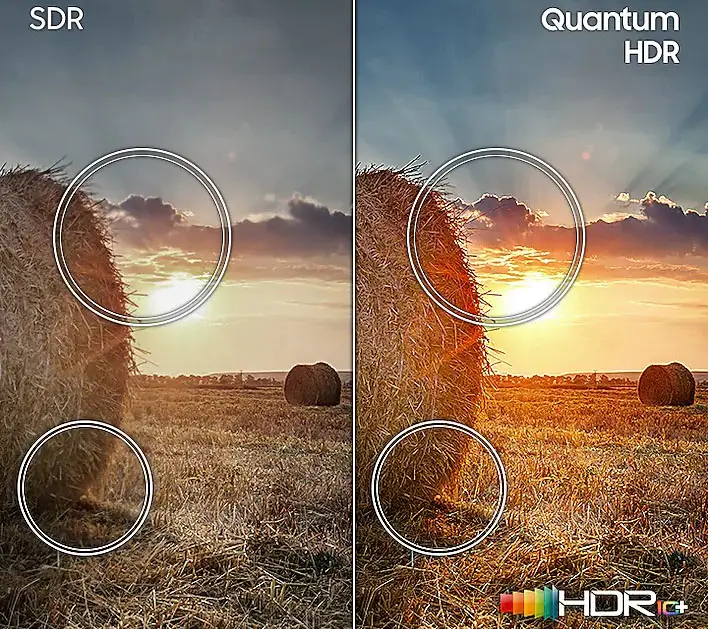
But for now and for the foreseeable future all Samsung TVs will continue to support only HDR10+ instead of Dolby’s offering. Getting this out of the way the Q60T supports the trio of HDR formats available which is the basic HDR10 that is needed for 4K UHD playback, HLG that is used for broadcasting and HDR10+ which uses dynamic metadata in order to provide the best image quality possible.
Color coverage
The Q60T is the last of the QLEDs which means is the last model that uses Samsung’s special Quantum Dot layer in order to display more vivid and lifelike colors. And while Samsung claims 100% coverage of the DCI-P3 color space we know that this is not entirely true as it is used mostly for marketing purposes.
According to our measurements the Q60T has about 89% coverage of the DCI-P3 color space which is still exceptionally good for it’s category. On the wider REC.2020 color space we got a coverage of 67% which is normal for this unit. With the Q60T being able to display Wide Color Gamut means it can create amazing color shades and decent gradients.
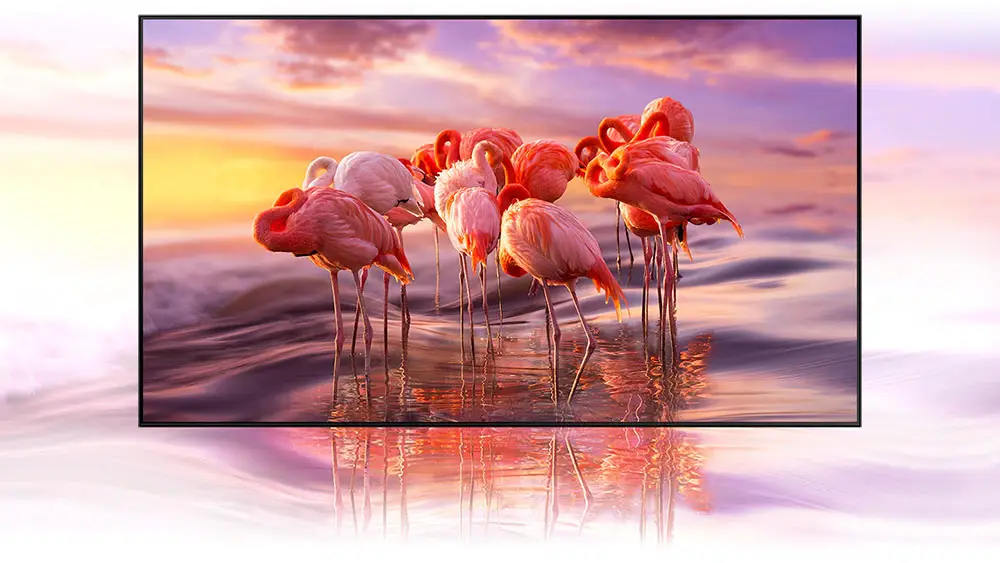
Motion performance
When it comes to motion performance things are not as crystal clear as we were hoping for. First of all the Q60T uses a 60Hz panel which is a downgrade from the 120Hz panel we saw last year in the Q60R. The 60Hz is using a 600Hz backlight dimming frequency which makes flickering almost non visible. But this high frequency is not used in all picture modes and it will switch into 120Hz which makes flickering visible.
This unit also supports motion interpolation in order to make the motion smoother by eliminating judder. This can be done by enabling the Picture Clarity setting in the menu. There are a couple of settings that you can adjust here with a judder slider along with a noise reduction option. The Q60T did show some ghosting during our tests and we cannot say we were thrilled by it’s overall performance.
Also available is the Black Frame Insertion (BFI) feature which inserts a black frame between two individual image frames and can be enabled with the LED Clear Motion setting. When enabled image can appear smoother but as a side effect there is a reduction in brightness and makes flickering even more visible as the frequency further drops to 60Hz.
As a last note we should mention that the Q60T does not support any kind of VRR technology which is a downgrade if you consider that last year’s Q60R supported FreeSync. For VRR you will have to jump one category and go for the Q70T if it definitely interests you.

Input lag
Let’s see how the Q60T fares with input lag. The unit comes with Auto Game mode which means that when you connect a console the TV can detect it and enable it automatically. As for the actual numbers with Game mode enabled we got an astonishing 10.8ms of input lag in both Full HD and 4K resolutions which is an improvement compared to the Q60R. Obviously without Game mode the input lag skyrockets to around 79ms so make sure you use that when playing video games. The TV also supports Auto Low Latency Mode (ALLM) if the connected device like a console also supports it.
To put it to the test we connected our PS4 console for a spin with a session of Call of Duty WW2. Out time with it went by very pleasantly with very fast and accurate controls and all our commands displayed on screen instantly. If you are looking for an affordable TV for your gaming sessions then the Q60T definitely fits the bill. Samsung did a great job in this regard.
Image quality impressions
When it comes to image quality the Q60T finds itself in a difficult position. It’s the last of the QLEDs and while it want to have the same DNA as it’s bigger brothers the kind of corner cuts in order to meet the lower budget meant that it had lost a lot.
On the bright side it seems that Samsung managed to slightly improve some areas compared to last year’s Q60R. With a bit better brightness in both SDR and HDR, slightly improved viewing angles and better input lag from last year the Q60T has a few things to show.

On the downsides the less capable Quantum Processor 4K Lite meant that we would loose the advanced AI upscaling while there is also a downgrade on motion performance as for 2020 this one gets a 60Hz panel instead of the 120Hz we saw last year. The Q60T uses a high frequency backlight but in many cases this would fall to much lower numbers making the end result average.
One thing that seems to be almost similar to last year is the color coverage as the Q60T managed to fare very good for it’s price. Obviously in SDR content things were much better than HDR where the capabilities of this unit left a lot to be desired for a QLED model. Not bad we would say but neither good also.
Audio Quality
Since the invention of flat TVs sound is one area that gives constant headaches to manufacturers as they struggle to improve the performance of their models with little or no success. There is simply not enough space that would allow for better and more complex systems to be used in this regard. For 2020 it seems that Samsung tried to rectify this by creating the Object Tracking Sound+ system that they use in their top units. But we are not going into details about this because unfortunately the Q60T had to drop this and use a more conventional 2 channels audio system that is widely used by most lower and medium tier TVs.
So what this unit has to offer in terms of audio? The two down-firing drivers of the Q60T allow for the 2.0 channels system to output a total of 20 watts of power. In theory this may seem too little but thinking of it from a TV perspective it is actually normal. The TV would go pretty loud without any major distortion but it was completely missing in volume, depth and prowess. The bass was also uninspiring and left a lot to be desired.
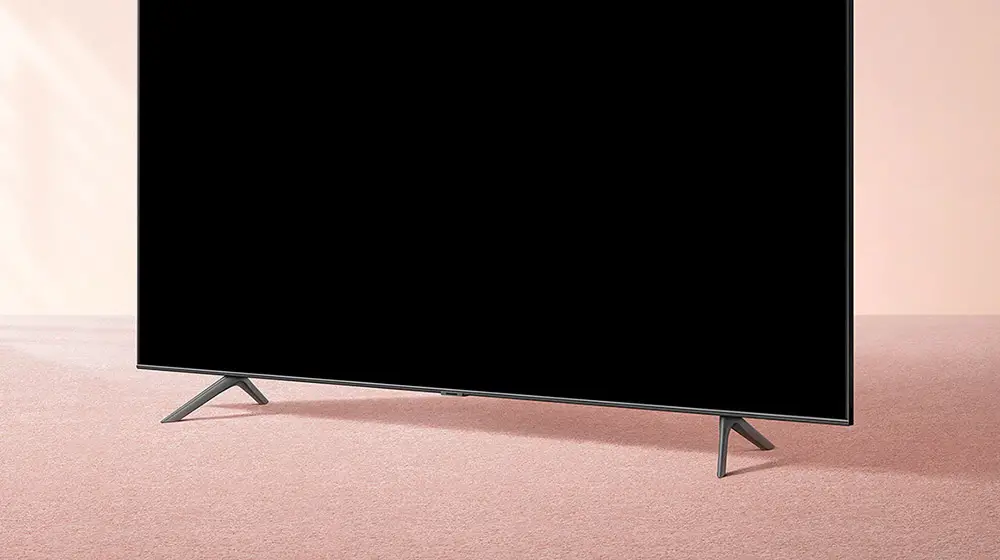
We do get some features here with one being Adaptive Sound. Keep in mind that there is also Adaptive Sound+ that is being used in the Q70T which is a more advanced system of the one we get here. With Adaptive Sound the TV can automatically make adjustments for the best sound experience possible according to what content is viewed at each specific time.
In general the output of the Q60T can be considered as average and in line with any other 2 channels TV audio system. Not something that can offer any kind of immersion but more than enough for casual and broadcasting viewing.
Inputs
When it comes to connectivity the Q60T features a pretty standard configuration. As we mentioned above this unit doesn’t have the famous One Connect Box as for 2020 Samsung decided to include it only with their very top tier units. As such all ports are located at the back of the main body towards the left side and separated into two groups with one of them looking sideways while the other facing backwards.
For the group that looks sideways we get two HDMI inputs along with two USB ports for connecting external storage. The only other connection here is the antenna input. In the second group that faces backwards we get a digital optical audio output, a third HDMI port, a composite video input, an stereo audio input and an Ethernet port for wired connection to the internet in case the wireless signal is not good enough.
A couple of notes here. First of all we are surprised to see Samsung still using HDMI 2.0 ports. While their 8K and all other 4K QLEDs feature HDMI 2.1 the Q60T is not. At least we do get eARC in HDMI 2 which is a good thing to have in case you require it. But the bad thing is that we loose one port compared to last year’s four. Also the USB ports are still ver 2.0 which is a shame. In this day and age USB 3.0 should be a standard but for some reason manufacturers still refuse to use it widely.
As for it’s wireless capabilities the TV comes with built-in WiFi as well as Bluetooth v4.2.
OS, Apps and Features
Being a 2020 release the Q60T comes with the latest version of Samsung’s Tizen. The smart platform has greatly evolved over the last few years and for this year Samsung tried to make it slightly simpler as we navigated through all it’s menus. Nothing major and if you have used Tizen before you will know how to find everything but the 2020 version seems to come with a dark UI that is complete different visually from the white one we saw previously. If it’s better or not we will just say that it’s a personal matter but to be honest we slightly liked the white one a bit more.
The launcher bar is still firmly positioned at the bottom and with any selection a second row will appear above giving you quick access to many other options like video streams and apps. Customization was always a strong feature Tizen had and continue to be offered here. And this is definitely needed as the number of apps being supported is simply staggering and if you like to use many of them you will need to place everything to your liking.
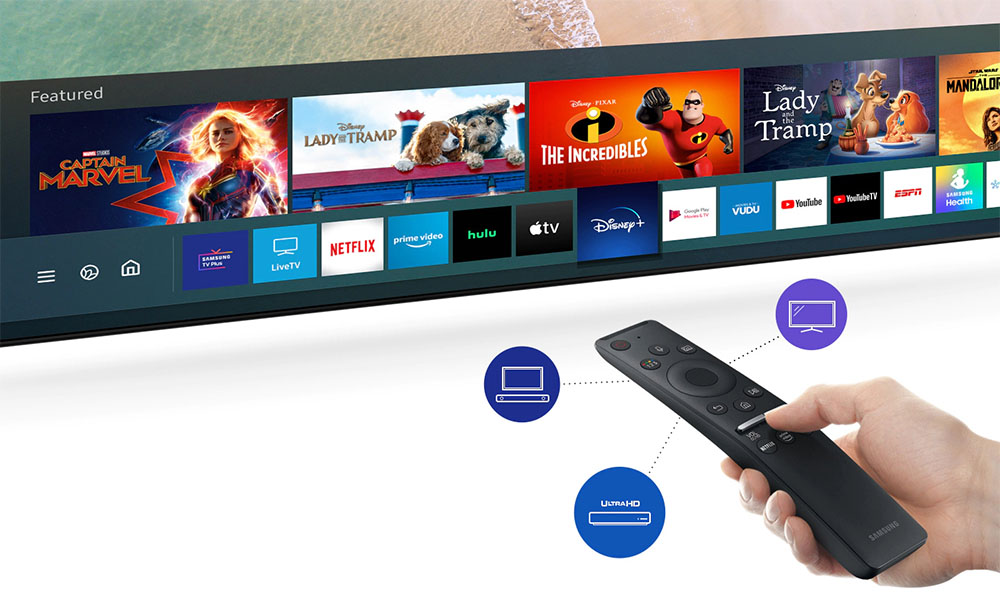
As for streaming all major names are present like Netflix, Youtube, Amazon, Hulu, Apple TV, Rakuten, Demand 5 and BBC iPlayer with some of them like Netflix and Amazon supporting both 4K and HDR. Navigation through the apps was very smooth and we didn’t notice any concerning lag when switching between them.
And while customization is one way to arrange your content and make your life easier Samsung has also included Universal Guide which is a feature that checks what you are watching the most and automatically creates a ‘For You’ page that includes content that you will most likely watch. This can be a very handy one if it happens you to have specific viewing habits making this page a fast to access portal to your favorite content.
The TV also has SmartThings integration which means that if you have other smart devices in your house like lights, electronic locks, smart power plugs and robot vacuums among others you can turn your TV into your central smart hub and control everything with it. Expanding to this is the inclusion of voice control.
The Q60T now supports Bixby, Amazon Alexa and Google Assistant so you can go ahead and make your pick. Combining SmartThings and voice control you can really create a complete hands free ecosystem for all your smart devices. Lastly Airplay is also supported for all of you Apple lovers and you can even use Siri for your voice commands if you prefer Apple’s voice control solution.
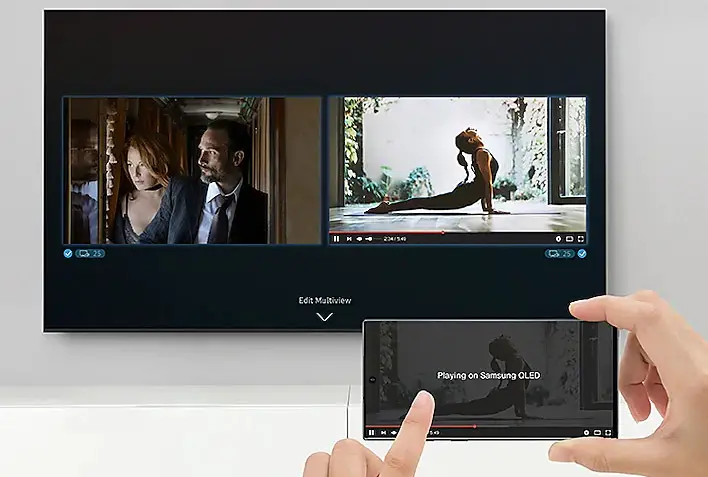
One new feature we find in many middle tier and top tier models in 2020 is Multi-View. Screen mirroring is a feature Samsung TVs have for many years and with Multi-View Samsung took it one step further. Now the TV can split it’s screen in two parts with one half showing content on your TV while the other half will mirror your mobile device screen. Now we don’t know how useful this feature can really be but it’s an interesting new addition to the 2020 models.
Last but not least we get the familiar Ambient mode. This function can turn the TV into a work of art as it can display various images and designs when the TV is not being used or it can even blend with the environment by displaying an image that hides it from plain view. This mode still draws electricity and we were never too fond of it as it’s usability is really very limited for most users.
Even having Tizen by itself is a major plus for any smart TV. The UI is simple and easy to use, there is a huge list of apps included or that can be downloaded and the supported features are enough for most situations. A big thumbs up from us in this area.
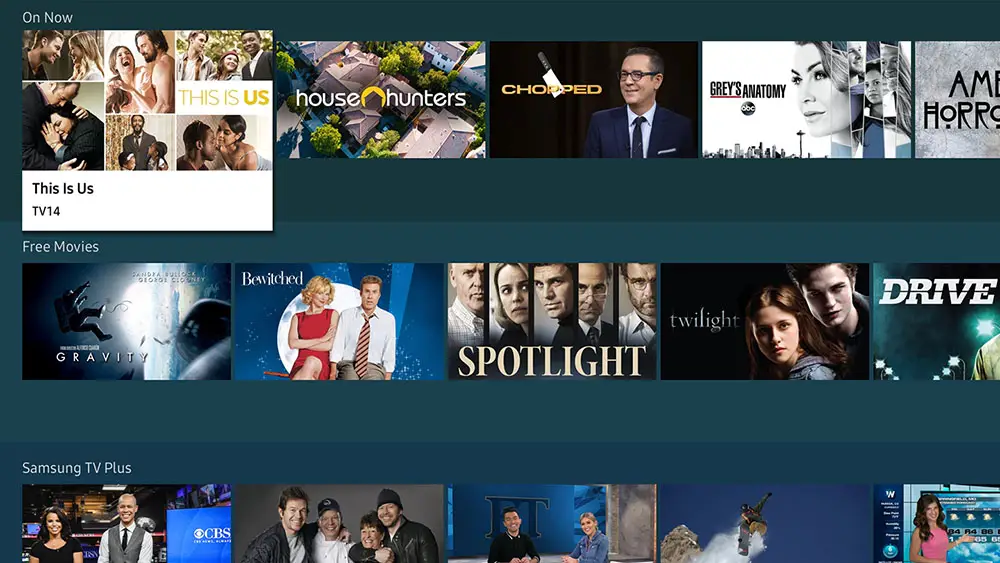
Final Thoughts
Closing our review what we can say is that the Q60T cannot be considered a clear improvement over the last year’s model. Obviously Samsung needed a filler between their Crystal series and their QLED models and in this regard this unit feels a little like a half baked solution.
Some areas where the Q60T did improve slightly include SDR and HDR brightness, viewing angles and input lag but the improvements are minor and nothing that could really make a difference. On the other hand there were some areas where it performed worse which is rather interesting. By using a less capable processor means that the Q60T lost the advanced AI upscaling while in the motion department the TV showed some ugly ghosting. For it’s HDMI ports we now only have three to use and there is no FreeSync available but at least one of them now supports eARC which was missing last year. But being the only QLED without a HDMI 2.1 is a bummer. Also if you want Dolby Vision you are out of luck as Samsung remains the only manufacturer that stays firmly behind the HDR10+ protocol.
Because the TV is not a clear improvement over last year does it make it bad? Not necessarily. The TV has enough qualities to make it a good TV. It can show very sharp 4K images with excellent SDR brightness, good contrast, very nice colors and extremely low input lag ideal for gamers. Also with it’s Tizen platform it includes all the streaming services and smart features you will ever need. With the right price the Samsung Q60T can be a good option for those that want some taste of what a QLED model can offer but cannot afford to go all the way with a more expensive one in the series.
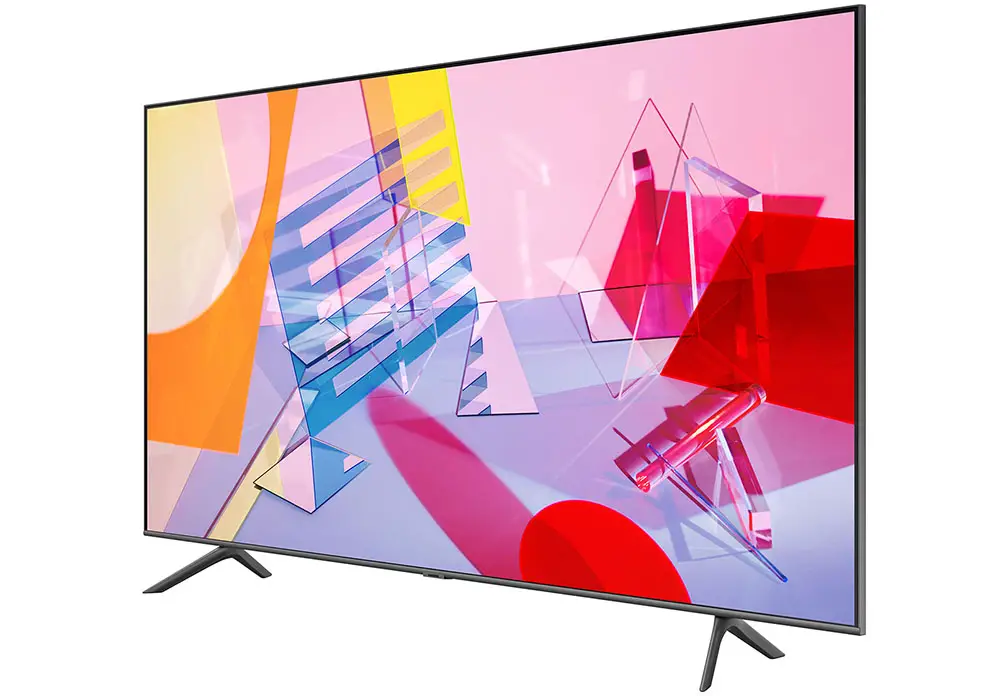
For more reviews you can check our dedicated 4K LED LCD TV reviews list or even look at our Product Reviews Table where you can find the brand and specific product you are looking for.
Cheapest Places to Buy :
*We are a reader-supported website. When you buy through links on our site, we may earn a small affiliate commission at no extra cost to you. Home Media Entertainment does not accept money for reviews.*

Something that I value in a TV is the motion smoothing mainly for watching soccer, otherwise I get a bit dizzy when I spend too much time in front of the TV. Since this Q60T has the BFI (even if it degrades the brightness a bit) it would still be good purchase. I am worried a bit about the ghosting part though.
Hello Daniel. Indeed the Q60T did show some ghosting. It was not so excessive to be bothering but it was there and we should mention it.
Samsung has been a good choice for TVs for me and my family. We want one on the kitchen wall, and as we just want to watch the news, I may want to check out exercise programs, maybe kids programs. This one seems a good buy for us. The family will probably watch it more than I think right now, but with the systems we have in the family area I think that we don’t need or want a lot of extras.
With family members working shift work, the desire to watch news comes at different times than if we were all on one shift. This is what made us consider a TV for the kitchen. Thank you for your information. I will share this with my husband when he gets in.
Sami
If you need any further assistance with your buying decision let me know Sami.
I have been looking to upgrade to a QLED TV so this was great to see. I like how your review covers everything I was wondering about. Looks like that the lower price did come at a great cost in specs. I can’t believe anyone is still making 60Hz TVs. 120 Hz is so much better. I agree that sound is a big issue with most of these new TVs. I have a soundbar to handle that issue so I am covered in this respect.
We were a bit surprised also to see the Q60T using a 60Hz panel Curtis. With the Q60R last year using a 120Hz panel we thought we would get the same. This is one of the downgrades that we didn’t like at all.
samsung q60t 55 inch 4k tv exact refresh rate please
The Q60T is using a 60Hz panel with a 600Hz backlight dimming frequency.
is q60r best..? or q60t..?
Each one has its own strengths. The Q60T has better brightness and lower input lag while the Q60R has better AI processing, better motion performance and more HDMI ports.
I just bought the 55″ Q60T yesterday and I’m so disappointed. I may have gotten a lemon but its picture lacks any detail or definition. I adjusted the picture settings in every combination possible and that improved nothing. My old 1080p Vizio has a better picture with more detail and the Samsung’s picture is no better than my 20-year-old Sony. In spite of all the research I did before buying this TV, it will be going back to the store because it doesn’t appear that it is able to upscale to even a 720p standard.
Hey Fred. Well, I cannot comment exactly on your TVs image quality since I cannot see what you see but if its so bad as you say then probably was a bad unit. The Q60T may not be the best out there but it’s definitely a good middle tier TV. If you could provide some more details on the problems you have with the image quality I may be able to give you a hint or two.
Thanks for the review, v helpful.
Do you have an opinion on how this TV compares to the 2020 Crystral model UE50TU8500?
Essentially, I am being offered this QLED model with a soundbar for £150 more – is it worth the increase or should I stick with the Crystal and Soundbar?
The Q60T has a Quantum Dot display which the TU8500 doesn’t which means better color reproduction, it has higher brightness and a more capable processor. Does these worth an extra 150 pounds? For me yes, but this is entirely my own opinion. It’s not a night and day difference but it sounds just about right for the price difference they have.
Thanks for the honest reply.
You are welcome. Let me know if you need any further assistance.
Samsung Q60T or LG SM8600?
Although these two are pretty close the LG SM8600 has a slight edge and is the better one.
Q60t mi yoksa q60r mi ikisi arasında kaldım sizce hangisi daha iyi görüntü sergiliyor
Hey there. Please next time write in English so everyone can read your comment. Now as for your question it’s a tough decision really. Both of them are really close and each one has minor advantages over the other. Probably I would go for the Q60R as it is definitely cheaper and image quality wise you loose almost nothing.
you Both televisions are the same in terms of Ps4 gaming. Thank you very much for the information you have provided.
You are welcome!